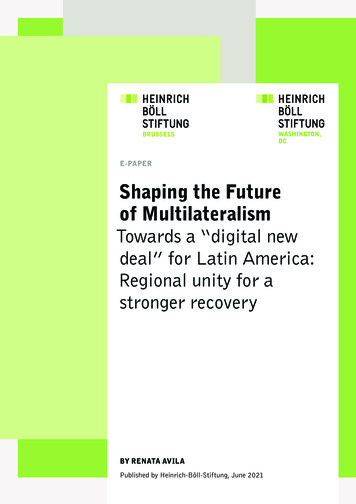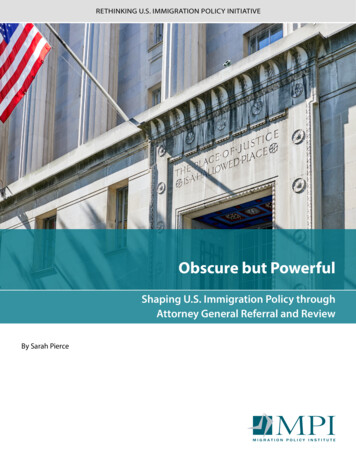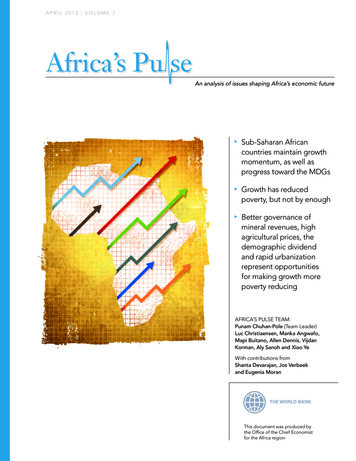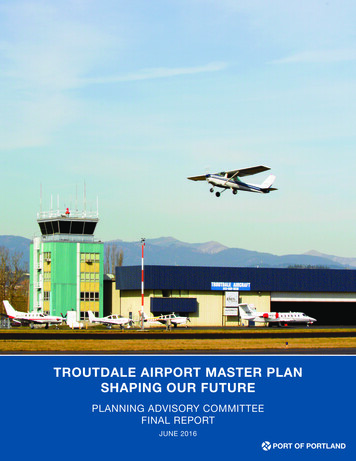
Transcription
E-PAPERShaping the Futureof MultilateralismTowards a “digital newdeal” for Latin America:Regional unity for astronger recoveryBY RENATA AVILAPublished by Heinrich-Böll-Stiftung, June 2021
About the AuthorRenata Avila is an international human rights lawyer and digital rights expert fromGuatemala with more than 15 years of experience working on cutting-edge issues relatedto technology and society. She is currently a HAI Race & Tech Fellow at StanfordUniversity, and she co-founded and leads the A Alliance for Inclusive Algorithms.She studies the politics of data, the evolution of transparency, and their implications ontrade, democracy and society, alerting audiences about a phenomenon she describes asdigital colonialism. She is an advisory board member for Creative Commons, Open Futureand Cities for Digital Rights. She also serves as a global trustee of the think tank DigitalFuture Society. She is a co-founder and Council Member of the Progressive International,among other roles.
ContentsTowards a “digital new deal” for Latin America:Regional unity for a stronger recovery4Emerging from the pandemic: regional digitalsovereignty or privatization 2.0?5Public-private partnerships to reduce the digital gap8Policy development needs to focuson the fundamentals9Whose transformation? Indigenous peoplesand a digital new deal10Lack of leadership opens way for digital colonialism11Converging crises, converging solutions12Conclusions and recommendations to the LAC region 15Reference list17
Towards a “digital new deal”for Latin America: Regional unity fora stronger recoveryThe absence of an integrated digital market and a unified political vision for techpolicy in Latin America and the Caribbean puts the countries of the region atrisk of dependency on a foreign private sector for their digital transformation.The investment that will be required to recover from the pandemic offers a uniquechance to break out of the current market logic and treat technology as critical socialinfrastructure that must be sustainable and requires citizen participation.In the first half of 2021, Latin America and the Caribbean continued to suffer fromthe global pandemic declared more than a year earlier. Governments again imposedlockdowns, and hospitals were stretched beyond the breaking point, turning awaypatients or rationing care for those admitted. Many schools and universities were stillteaching remotely, and telework was ubiquitous for those fortunate enough to still havework. Governments were bracing for a slow recovery, with bleak prospects of the kind ofeconomic growth that would be needed to reduce a poverty rate that had climbed to levelsnot seen in three decades.Country and sector leaders at the same time have been dealing with convergent crises thatare further exacerbated by the pandemic. A social crisis stems from general mistrust ingovernments across the region that often are tainted by corruption, abuse of power,and actions that erode individual and collective rights. An economic crisis has millionssliding into poverty or even further into extreme poverty. And all of this is unfoldingamid the climate crisis already affecting the region, especially the most vulnerable andfragile countries.One possible overarching solution to all of these dire scenarios has the potential to deliverbetter social and governmental institutions, cleaner industry, and better job opportunities:digital transformation.Technology has been portrayed as a savior during the Covid-19 pandemic. Publicand private sectors across the region have claimed accelerated signs of progress indigitalization as they develop innovative solutions to address the pandemic. Thesesuccesses make it almost certain there will be a multi-sectoral push to invest incontinuing such digitalization.Such a process carries risks for the region, especially if driven purely by profit motives,with little regard for the people and communities affected. But judicious action thatleverages the region’s creativity and the potential of young innovators who were hands-onin supporting governments during the pandemic can turn a potentially disadvantageoussituation into an opportunity for local communities, homegrown companies, and theregion’s people as a whole.Towards a “digital new deal” for Latin America: Regional unity for a stronger recovery 4 / 21
A positive agenda matching the needs of the region will require unified, regionalmechanisms to nurture policies and projects that target key areas and groups. It willnecessitate building of institutional infrastructure for a shared digital future throughcollaboration, cooperation, and refined strategies. The goal should be to emerge from thepandemic with a clear vision for a more integrated digital public infrastructure.Ultimately, in order to be sustainable in terms of the ability of the region’s people andinstitutions to follow through on the promise of a new digitalized era, any such plans mustbe developed in the most inclusive, consultative process possible. Only then can the resultstruly produce a constructive, productive digital transformation that serves all the peopleof Latin America and the Caribbean.Emerging from the pandemic: regionaldigital sovereignty or privatization 2.0?Technology writer and thinker Evgeny Morozov describes most tech-related interventionsdeveloped for the Covid-19 crisis across the globe as “digital plasters,” i.e. temporarysolutions, which are completely dependent on a handful of private firms. “The feastof solutionism unleashed by Covid-19 reveals the extreme dependence of the existingdemocracies on the undemocratic exercise of private power by technology platforms.”With only a marginal market share of the global tech economy, Latin America and theCaribbean (LAC) are at an even further disadvantage. Also, unlike the European Union,the region lacks an integrated digital market and most of the countries don’t have nationaldigital-sovereignty strategies, adequate data regulation, or an integrated political visionfor tech. As Morozov continues, “Our first order of business should be to chart a postsolutionist path – one that gives the public sovereignty over digital platforms.”Latin America0,2%Africa1,3%United States68%Europe3,6%Asia (excluding China)5%China22%Latin America has lowest share of global digital economyUS firms dominate the global digital economySource: UNCTAD Digital Economy Report 2019, Center for Global Development.Get the data. Created with DatawrapperTowards a “digital new deal” for Latin America: Regional unity for a stronger recovery 5 / 21
Without a clear strategy, governments are more likely to adopt yet another technological“solution” or invest in yet another app based on novelty rather than on integration andinteroperability. And in the case of Covid-19, it was urgency, built upon an establisheddependence on technology from China and the United States that has most oftendriven decision-making. Apps and tools were rapidly deployed, not without glitches anddisruptions, leaving many people behind who theoretically were to be served, especiallyin a region with vast populations unable to connect – and afford the costs of remainingconnected. That is especially the case in particularly poor parts of LAC such asCentral America.So, the public sector often acquires solutions spontaneously, announces them loudly, anddeploys them without adequate consideration for human rights or consumer protections.That was what happened when Guatemala deployed a contact-tracing app during theCovid-19 emergency. It collected users’ exact locations even when the app was closedand retained a shocking 10 years of data in a country that lacks adequate human rightssafeguards on any terms and that is one of the many in LAC without a privacy and dataprotection law.The effect of technology on society is inescapable. Today, almost every governmentalactivity in the region is mediated by interactions with technologies and services controlledby increasingly concentrated conglomerates. And the main providers of software andhardware, the United States and China, are engaged in a market confrontation thatescalated in 2020 and placed LAC countries in the vulnerable position of divided loyaltiesand dependencies, further restricting their choices of technology to bridge urgent digitaldivides. While competition between two tech superpowers might seem on the surfaceto be advantageous for offering choice to consumers, the United States is undercuttingprospects of market competition with an aggressive strategy to coerce other countries,including in Latin American, to join it in banning Chinese technologies, such as 5G, onthe grounds of what the U.S. State Department under then-President Donald Trumpcalled the “long-term threat to data privacy, security, human rights and principledcollaboration posed to the free world from authoritarian malign actors.” The novelapproach was called the Clean Network Initiative, and it essentially consisted of signingon dozens of countries and tech-service providers to ban, on grounds of cybersecurity,technology that didn’t meet specific parameters that certain Chinese tech would not meet.As of publication of this paper, it was uncertain whether the Biden administration wouldcontinue such endeavours.While Europe strives to compete and find a niche in the global digital transformation,Latin America and the Caribbean lags, without significant presence in software orhardware markets or a lead in any tech-related industry. There is some potential inMexico, as the start-up epicentre and in initiatives like Mercado Libre, the successfule-commerce retailer based in Latin America. It operates in 16 countries and has 3,200employees, but the industry is still heavily dependent on Silicon Valley dynamics andits basic infrastructure such as their cloud services. In the past two years, differentTowards a “digital new deal” for Latin America: Regional unity for a stronger recovery 6 / 21
European countries have advanced their digital sovereignty concepts. “Digital sovereigntyis—especially in Europe—now often used as a shorthand for an ordered, value-driven,regulated and therefore reasonable and secure digital sphere. It is presumed to resolvethe multifaceted problems of individual rights and freedoms, collective and infrastructuralsecurity, political and legal enforceability and fair economic competition.”These digital sovereignty strategies also drive all institutions, funding, and researchmechanisms in those countries or blocs towards achieving that vision. That mitigates therisk that they would become heavily reliant on foreign technologies, and strengthens theircompetitive and comparative advantages through a digital single market. Regulationis a key element of digital sovereignty, as illustrated, for example, by the EuropeanCommission’s pending Digital Services Act. As the EC outlines it, “The new rules areproportionate, foster innovation, growth and competitiveness, and facilitate the scalingup of smaller platforms, SMEs and start-ups. The responsibilities of users, platforms,and public authorities are rebalanced according to European values, placing citizens atthe centre.” Strategic litigation also plays a role in keeping the area competitive andinnovation flourishing, including the antitrust and consumer-protection proceedingstaking place now against Big Tech in Europe.In contrast, LAC governments are behind in developing a collective strategy to gainleverage over the tech sector. The situation is even more desperate in the public sector, asall countries are entirely dependent on a concentrated foreign private sector to digitalizekey government functions and even entire social sectors, such as education. This leadsto a silent, unaccountable, and rapid privatization of governmental functions such asonline learning, remote health care provision, channels to connect with citizens, and evengathering of agricultural data. Across the region, the institutional digital transformationis not strengthening the public sector digital infrastructure and skills inside theinstitutions, but rather quietly replacing core public functions with privately controlleddigital platforms. Tech giants are providing government services, sometimes as donationsor at a low cost, effectively taking over entire sectors. For example, Intel computersdonated to schools become the prevalent educational technology.However, the seemingly generous donation also comes with a price: the data of the peopleusing it. With exclusive and private access to key datasets, the tech giants then havea competitive advantage over the local companies. Since the countries in the regionfail to consider data a public asset and simply let it fall into the hands of their serviceproviders, they limit their ability to use public data to address the most pressing localissues. Datasets on pollution and inequality, energy consumption, or mobility are crucialto develop policies for more environmental protection and green innovation.In the pandemic, for example, the digital infrastructure to deal with the crisis wasprovided mostly by U.S.-based companies, often subsidized with public funds. Projectsranged from Microsoft providing a digital-services platform in partnership with theTowards a “digital new deal” for Latin America: Regional unity for a stronger recovery 7 / 21
Inter-American Development Bank (IADB) to Google tracking user mobility and reportingthe results to governments to understand behavior patterns, and Facebook openinginformation channels via WhatsApp for the Secretariat of Central American Integrationto educate people about Covid-19.A worrying trend in the region is the public sector’s rapid digitalization of socialprotection systems, despite a generalized lack of policies, processes, and technologiesto protect the vulnerable. These developments create somewhat of a contradiction,considering the aim is to get more of the vulnerable population digitally connected fortheir benefit. But instead of robust systems facilitating digital inclusion of the many sothey can participate effectively in systems that directly affect them, the public sectoroften relies on technologies designed for other societies, and acquires them throughnon-transparent, non-participatory processes. One example is the Chilean Ministry ofSocial Development’s creation of a Childhood Early Alert System to prevent violationsof children’s rights by identifying and prioritizing children and teenagers who show riskfactors. But the system failed the communities it was intending to assist, because it wasdesigned to fit the needs of a predecessor effort in New Zealand and did not take intoaccount local needs. Both the model and the datasets used to run the system producednumerous false positives.Another trend across Latin America and the Caribbean is to promote the use of artificialintelligence (AI) to deploy large-scale technology interventions to make government agileand rapidly reduce gaps or improve the delivery of benefits in targeted social programs.But the initiatives are not necessarily rooted in the region. Only a few of those projectsare led by local companies and communities. On top of that, the models are often opaqueand proprietary. The datasets are poor. Seven countries in the region now at least have AIstrategies and policies under discussion or at an early implementation stage: Argentina,Brazil, Chile, Colombia, Costa Rica, Mexico, and Peru. But national and regionalregulation of AI is still nascent when compared with more robust regulatory frameworkselsewhere, clouding the projects with policy uncertainty.Public-private partnerships to reducethe digital gapAs the region emerges from the pandemic, both governments and the private sector likelywill spend enormous sums to create robust digital infrastructure to support the recoveryand LAC’s future. However, the region’s countries run the risk of consolidating theirdigital dependence on Big Tech, and instead of creating opportunities, delegating theirdigital future to powerful quasi-monopolies, as the world did during the pandemic.The region’s governments have given little to no indication of any plans to direct digitalinfrastructure investment to local companies and public institutions, and competitiveprocurement processes will probably lead to the Silicon Valley winners taking it all,Towards a “digital new deal” for Latin America: Regional unity for a stronger recovery 8 / 21
as local companies cannot compete with the power they concentrate. As loans andinvestments to alleviate the pandemic originate from China, the International MonetaryFund (IMF), the IADB, the Central American Bank for Economic Integration, and similarentities, the accompanying spending rules should consider the potential effects on theregion’s digital future and its lagging capacity to develop local industries providing vitaldigital infrastructure.This can only be achieved with procurement guidelines that are designed especiallyto target small technology companies and locally designed platforms, services, andproducts, and that require government procurement to grow. Some of these already exist –educational technology is growing in the region, for example. This kind of approach mighttake longer, and emerging industries might need additional investment and support, butit is a rapid way to develop a market, especially when technology giants such as Googlejump in to help with funding for small businesses in trouble.Policy development needs to focuson the fundamentalsLatin America lacks a uniform approach to regulating key digital areas and enablinga unified digital market. The region is active in cybersecurity, taking fragmentedapproaches to privacy and data protection, and working on some nationally led effortsfor AI. But there are no results at a regional level. Legislation also is fragmented;even trade agreements such as the U.S.-Mexico-Canada Agreement (USMCA) and theComprehensive and Progressive Agreement for Trans-Pacific Partnership (CPTPP), bothof which might create a uniform basis for domestic regulation and standards, containmany variations from one pact to another.One area where a coordinated regional policy at the intersection of technology andsocial rights could improve public-sector response is in health. At the simplest level ofdigital collaboration, data exchange, LAC does not even have a shared agenda and aregulatory framework for mandatory data sharing. In the future, this will be one of thekey aspects of regional digital transformation to strengthen health-information systemsand interoperability for evidence-based decision-making.A robust, post-crisis policy to achieve an effective digital transformation will requireregional reforms on competition law, taxation, data ownership, consumer protection laws,and labor laws. And even those elements should be preceded by a process to update thecurrent Intellectual Property Rights systems, which is unprepared to deal with upcomingchallenges such as AI.Even before the pandemic, no country in the region had even started to develop a longterm vision for the areas outlined above. A few – Mexico, Chile, Colombia, and Brazil,Towards a “digital new deal” for Latin America: Regional unity for a stronger recovery 9 / 21
for example – seem focused on the latest hot thematic trends, such as AI, even though theregion is neither a significant competitor nor a leading market in that field. Furthermore,as the pandemic made evident, their populations struggle with basic connectivity andother deep economic disadvantages that leave them utterly unable to seize on the newwave of technologies for social and economic development.The region has the institutional infrastructure to develop a digital single market. It is thepolitical will that is lacking. The Organization of American States (OAS), for example,once produced somewhat useful model laws, but more recently has largely neglected itsrole in legal harmonization.Whose transformation? Indigenouspeoples and a digital new dealOne of the critical questions of any digital transformation is who gets tolead and influence the process. The pandemic highlighted the multi-layeredexclusion of indigenous communities from the State and the private sectorvia language divides, infrastructure inequalities, and institutional racism.Governments focused their responses primarily on urban populations speakingthe dominant languages, Spanish and Portuguese, even as indigenous peoplessuffered a disproportionately high toll from Covid-19.Any recovery plans and any digital new deal for the region must addressthis exclusion, not only because it will optimize the results for everyone, butbecause it is mandatory. Most of the countries in the region are signatories tothe Tribal Peoples Convention of the International Labour Organization(ILO 169), requiring states to carry out consultations with indigenouscommunities on any decisions that affect them. The convention should be readtogether with the United Nations Declaration on the Rights of IndigenousPeoples and the OAS Declaration on the Rights of Indigenous Peoples, whichcontain similar exhortations.But underlying these requirements are the benefits: indigenous peoples couldbring fresh thinking and innovation for more inclusive visions, concepts, andpractices. Their involvement could draw on lessons from, for example, theMaori Data Sovereignty initiative in New Zealand and, closer to home,strategies by Bolivia’s Digital Agency to develop software locally and toacknowledge indigenous communities in decisions about digital sovereignty.The result could be a recovery and a digital transformation that takes fulladvantage of invaluable indigenous knowledge to help correct structuralinequalities, address historic injustices, and pave the way for a moresustainable future.Towards a “digital new deal” for Latin America: Regional unity for a stronger recovery 10 / 21
Lack of leadership opens way fordigital colonialismDigital trade, conditioned loans for digital infrastructure, and aid agreements have becomethe modern vehicle of digital colonialism. I define digital colonialism as the deployment ofimperial power over a vast number of people via rules, designs, languages, cultures, andbelief systems that serve the interests of dominant powers. In the past, empires expandedtheir power by controlling critical assets, from trade routes to precious metals. Today, it isnot States but technology empires that dominate the world by controlling critical digitalinfrastructure, data, and the ownership of computational power. By collecting the personaldata of citizens on a scale unprecedented in human history, for instance, companies canserve as conduits of misinformation and disinformation campaigns that can alter the flowof global geopolitics and even change the outcome of elections.In recent years, global trade discussions have increasingly touched on digital issues, suchas cross-border data transfers, online privacy, cybersecurity, spam regulation, and netneutrality. At the same time, Big Tech companies have accelerated their collaboration andprovision of services to governments, essentially replacing the State in providing critical(digital) infrastructure. It has been an easy process for Big Tech, as the region is one of theleast competitive in digital innovation (OECD, 2019) and relies on Asia, North America,and Europe to lead on technological modernization. Funds for research and developmentor serious public and private investment in infrastructure are insignificant comparedwith areas of the globe that lead the sector. Efforts towards digitalization are focused onincreasing productivity, often for the benefit of foreign owners, rather than focusing onserving the people and on improving the health of the planet.As noted earlier, political leaders in the region show little ambition to build a coherent,cohesive strategy towards a single digital market. They don’t negotiate digital-tradeissues as a block or try to unify digital-rights frameworks across Latin America andthe Caribbean. What diplomacy exists in the field is fragmented, heavily influenced bycorporate lobbies, and lacking in opportunity for citizen participation and scrutiny.Some LAC countries have rushed unilaterally to enter major trade agreements with nonLAC players, pacts that include significant digital-regulation terms. If that becomes themodel for the region, it will perpetuate fragmentation and will risk excluding smallereconomies that, by virtue of their limited capacity, are not equipped to fulfil the termsof such pacts among major players. Two examples are the Digital Economy PartnershipAgreement (DEPA) among Chile, New Zealand, and Singapore, which was virtually signedin June 2020, in the middle of the pandemic, and the USMCA, which effectively replacedthe North American Free Trade Agreement (NAFTA) in July 2020.Towards a “digital new deal” for Latin America: Regional unity for a stronger recovery 11 / 21
DEPA is a new type of trade agreement that aims to create a framework for the digitaleconomy and is composed of different modules that can be flexibly expanded as thepartnership evolves. The accord prohibits requirements to maintain data locally, and it isweak regarding data protection.The USMCA is the most significant digital trade agreement in recent times andundoubtedly will shape the region, and not necessarily for the good. It sets the bar forrights protections particularly low. According to Brookings Institution’s Joshua P. Meltzer,the USMCA “expands upon the digital trade commitments” in the CPTPP, expresslyexcluding government procurement from its scope, relaxing digital customs or taxes, andfully liberating cross-border data transfers and the transfer of personal data. The USMCAalso forecloses the possibility of member States requiring data localization, except inthe case of financial services and only as a last resort. It also limits the possibility ofrequirements on the transfer of or access to source code. And it establishes a systemof consensus-based standards on cybersecurity, with an overly flexible and ambiguousreference to best practices, an approach that appears to be an effort to push signatoriesto adopt harsh measures against Chinese technology.Converging crises, converging solutionsFor a fair and just digital transformation, LAC countries must identify and exploit theirdigital potential beyond the current market logic, and structure transformations to makethe results compatible and complementary with their commitments under the ParisAgreement and the U.N. Sustainable Development Goals. Only then can LAC countries andtheir citizens be informed participants in regional and multilateral treaties that will shapetheir digital future.The digital and green transformations should go hand in hand in the region to developthe missing positive agenda and a vision for reducing the multiple inequalities acrossLatin America and the Caribbean. As the Organization for Economic Cooperation andDevelopment (OECD, 2020, OECD Policy Responses to Coronavirus) stated, the pandemiccould become an opportunity to lay the foundations of a new social contract, movingtowards stronger social protections, a well-defined production strategy, low-carbondevelopment, and financial sustainability.Leaders of Latin America and the Caribbean must do much more to ensure that funds puttowards the pandemic recovery that are intended to bridge digital gaps and transformindustries and State institutions for the digital era do not lock the region’s technologicalfuture to terms and conditions dictated by China, the EU, the United States, or powerfultech lobbies. The recovery period should be inclusive and flexible to design new, agileinstitutions for a green, inclusive digital future that also works for middle- andTowards a “digital new deal” for Latin America: Regional unity for a stronger recovery 12 / 21
low-income countries. It is a unique opportunity to include society as a whole in all stagesof the process.Integrating a green and inclusive vision of the future in the region’s digital transformationcan create the diplomatic advantage for the next wave of aid, trade, and cooperationagreements. Some of the possibilities will imply concessions and data-sharing mechanismsin key areas where the private sector generates the data countries need to shape theirclimate policies. Similarly, collective dynamics in the region could shape a new approachto data sovereignty, where peasants and indigenous populations generate and benefit fromthe data and biodata commons, exploring new models of data ownership and management.The region has a number of groupings of various sizes and configurations that theoreticallyare aimed at regional integration, but none have shown an interest in or ability tospearhead such a pandemic-spurred digital transformation. The Central AmericanIntegration System (SICA) contains no mention of anything related to digital issues. TheOAS has not delivered a unified digital vision. Other mechanisms, such as the Bolivarianalliance ALBA, the Union of South American Nations (UNASUR), and the Community ofLatin American and Caribbean States (CELAC) have been largely irrelevant during thecoronavirus crisis, and are too weak and fragmented to serve as a forum for consensus forthe recovery.For coordinated funding, the entities that will play a critical role are the IMF, the IADB,the Latin American Development Bank, the Economic Commission for Latin America andthe Caribbean, the World Bank, the Central American Development Bank, and the NewDevelopment Bank established by the BRICS, as well as the U.S. Agency for InternationalDevelopment and Canada’s International Development Research Center. While allthe listed entities usually require metrics of efficiency and effectiveness that privilegetechnologies and solutions shaped in the Global North, LAC countries should press fordialogue to explo
Towards a "digital new deal" for Latin America: Regional unity for a stronger recovery 5/ 21 A positive agenda matching the needs of the region will require unified, regional mechanisms to nurture policies and projects that target key areas and groups. It will











